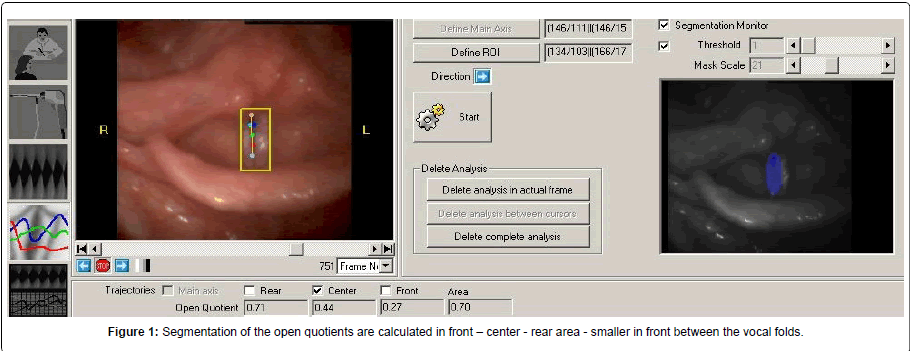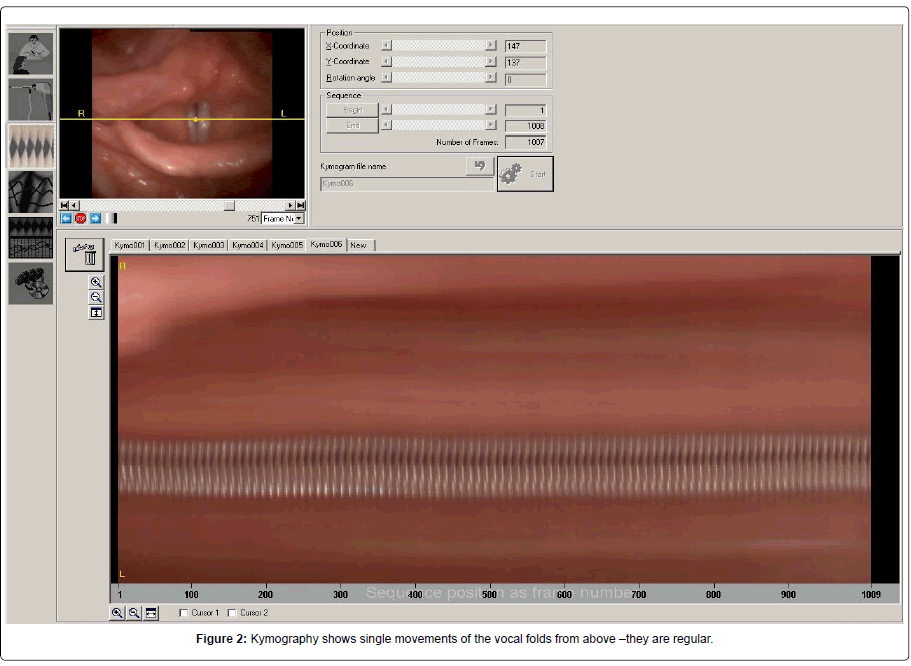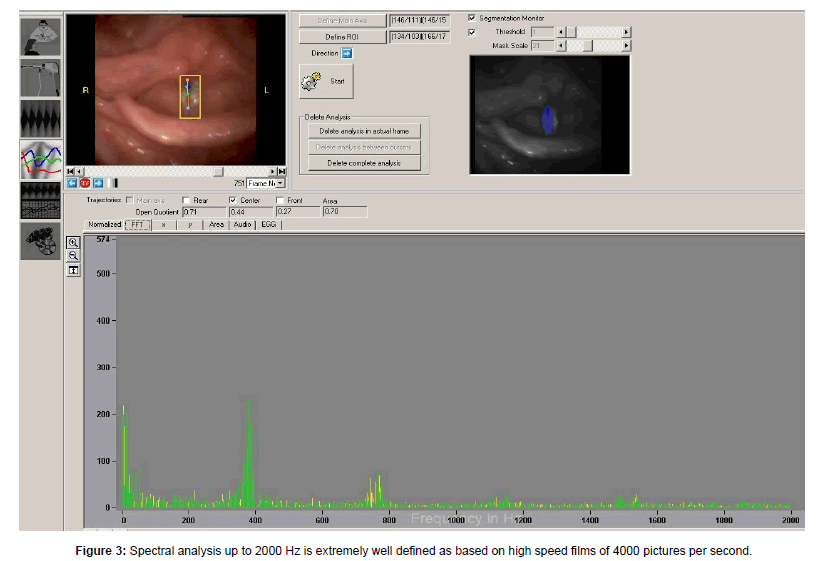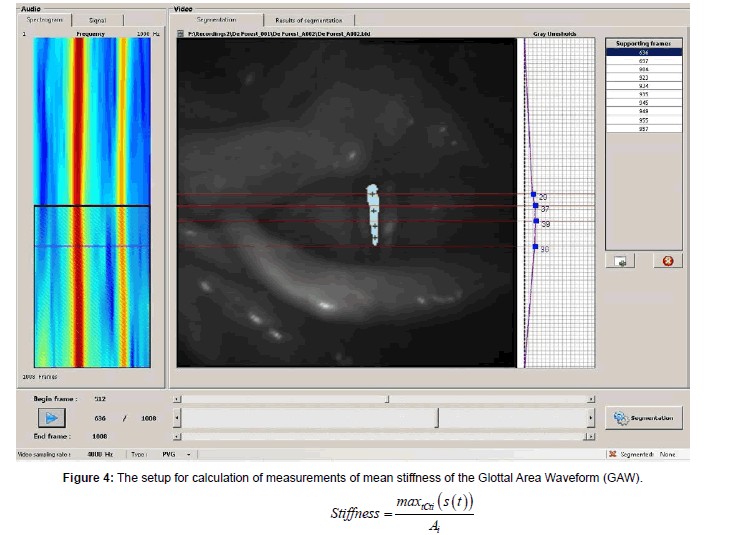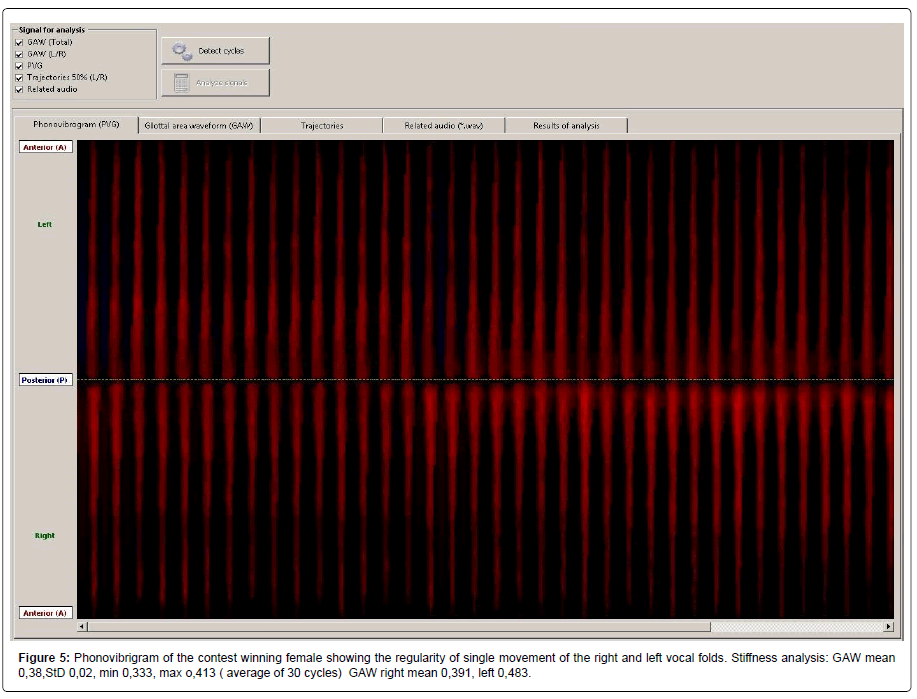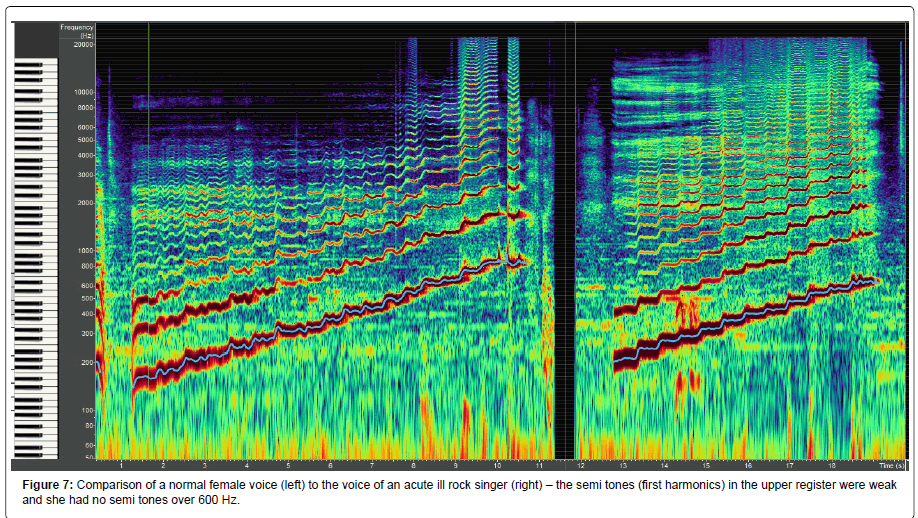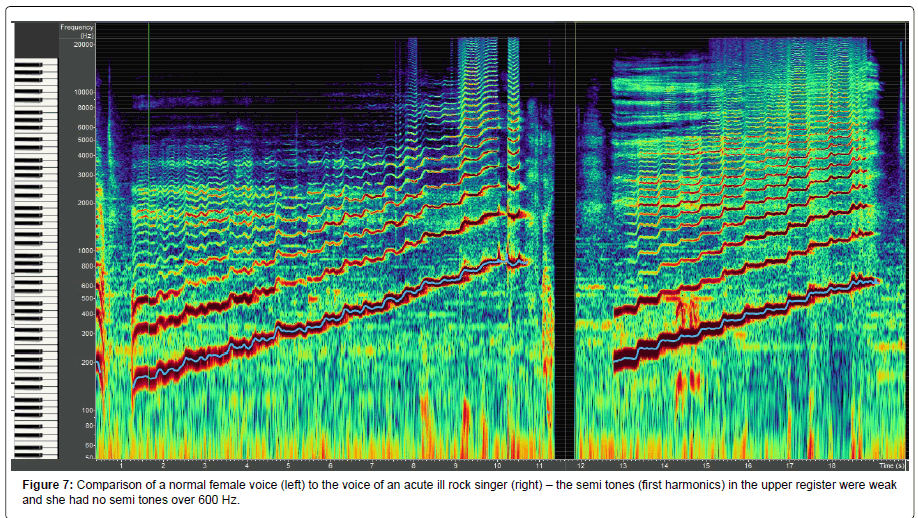Technology Advances in Diagnostics of Vocal Folds Function
Received: 29-Dec-2014 / Accepted Date: 16-Feb-2015 / Published Date: 20-Feb-2015 DOI: 10.4172/2161-119X.1000191
Abstract
There are new aspects in voice research where the patient in the future will benefit from advanced diagnostics. Since a clinical routine with high speed films showed that irregularity of the vocal folds hardly ever was the case, speech therapy for dysfunctions for the vocal fold in many cases was doubted. This was also the case for documentation of irregularity of overtones up to 20.000 Hz with a stable and well documented overtone analyzer. What is next is to bring larynx functions understanding into a position to be part of among others genetic syndrome analysis.
Keywords: Technology advances, Voice, Diagnostics, Treatment
249424Introduction
The new tools related to high speed films software for clinical use have now been on the market for several years [1]. Combined with electroglottography [2] and kymography, a more nuanced evaluation of the voice is possible. The software includes quantitative measures of the closure of the vocal folds as well as stiffness, a calculation of maximal amplitude versus maximal speed of the vocal folds. Jitter and other measures can also be measured on line on high speed films [3-5]. A new software by the firm Sygyt seems to be clinically feasible to measure overtones exactly and quickly in patients.
Genetic aspects have become in focus as a routine to define the patients’ voice related lactose genes [6] and mannose lectin genes [7]. It is not only the vocal folds mucosa which is of interest, but also the whole larynx mucosa. The documentation can till now only be shown in the clinic with the overtone analyzer of the voice (Sygyt Software) before and after treatment. In singers the new aspects are of ectreme importance.
When it comes to treatment - a part from excluding provocations, it seems that the antihistamine fexofenadine is very effective [8] to hinder infections. We know that it hinders swelling and it is an effective prophylaxis in patients with genetic mannose binding lectin, but we need documentation. An aspect for documentation is also to make patients focus on a healthy lifestyle. Other genetics factors should be focused on in the clinical work [9]. It is a problem that in the 1000 multiple genes prospects in Oxford, the voice is not included at all [10], the voice aspects being underrated as a part of verbal communication.
We are focusing on optical coherence tomography [11] as a possible quantitative measure of oedema of the arytenoid region as seen on high speed films in patients with genetic intolerance, allergies and reflux. As in eye diagnostics it is shown to be possible to make economically feasible probes for the larynx at nanometers measurable larynx level [11,12].
Methods of Technical Advances
Analyses are made of a European prize winning female of popular music with high speed films
Software calculations with high speed films (Wolf Ltd.) included
1. Segmentation
2. Kymography
3. Spectral analysis
4. Speed analysis with the formula

Where Ti is the duration of ith cycle in miliseconds (ms), Ai is the dynamic range ( max-min) for ith cycle and s(t) is the magnitude of the 1st derivative of considered signal for ith cycle (t C Ti).
Overtones analyses (Sygyt Software, Overtone Analyzer) included
1. Comparison of a normal female voice to a patient voice (non singer)
2. Comparison of a normal female voice to a patient voice (singer).
Results of Technical Advances
With an extremely stable phonovibrogram of a contest winning female singer is presented. Segmentation, kymography, spectral analysis up to 2000 Hz and stiffness analysis (Figures 1-7).
Discussion
It has been discussed if a clinical paradigm shift of understanding larynx functions is underway. There are many new aspects usable online on high speed films, the same is the case with the overtone analyzer where the patients’ understanding of what is going on is optimized by comparing on line with a normal male or female voice from the lowest tone to the highest tone, one tone at a time without taking breath in between. The main issue is to document treatment effect of several pharmacological aspects.
The genomic measures bringing voice into the basic genetic communications research for clinical use in the future, is related to our clinical experience with lactose intolerance and mannose binding lectin where patients untreated, are hoarse. They were to be effectively treated for their hoarseness with lifestyle correction supplemented with the antihistamine fexofenadine as well as local cortisol inhaler in the throat [13,14]. The optical coherence tomography is one of the next steps to document epithelial dysfunctions in the same way as it is done in eye diagnostics and esophageal disorders [12,15].
Conclusion
An approach has been made to present new methods of high speed films and overtone analyses to make refined diagnoses with aspects of treatments of laryngeal disorders including genetics.
References
- Kunduk M,Doellinger M, McWhorter AJ, Lohscheller J (2010) Assessment of the variability of vocal fold dynamics within and between recordings with high-speed imaging and by phonovibrogram.Laryngoscope 120: 981-987.
- Pedersen M Fog (1977) Electroglottography compared with synchronized stroboscopy in students of music. The study of sound, Tokyo 18: 423-434.
- Dollinger M, Berry DA, Huttner B, Bohr C (2011) Assessment of local vocal fold deformation characteristics in an in vitro static tensile test.J AcoustSoc Am 130: 977-985.
- Banjara H,Mungutwar V, Singh D, Gupta A (2014) Objective and subjective evaluation of larynx in smokers and nonsmokers: a comparative study.Indian J Otolaryngol Head Neck Surg 66: 99-109.
- Lohscheller J, Svec JG, Dollinger M (2013) Vocal fold vibration amplitude, open quotient, speed quotient and their variability along glottal length: kymographic data from normal subjects. LogopedPhoniatrVocol 38: 182-192.
- Zhao J, Fox M, Cong Y, Chu H, Shang Y, et al. (2010) Lactose intolerance in patients with chronic functional diarrhoea: the role of small intestinal bacterial overgrowth. Aliment PharmacolTher 31: 892-900.
- Pedersen M, Eeg M (2012) Does treatment of the laryngeal mucosa reduce dystonic symptoms? A prospective clinical cohort study of mannose binding lectin and other immunological parameters with diagnostic use of phonatory function studies. Eur Arch Otorhinolaryngol 269:1477-1482.
- Pedersen M (2014) Future aspects of cellular and molecular research in clinical voice treatment. Guest editorial. Advances in Cellular and Molecular Otorhinolaryngology 2: 24442.
- Pedersen M (2014) Chapter 1.1.18, Genetics, European Manual of Phoniatrics In press.
- 1000 Genomes Project Consortium, Abecasis GR, Auton A, Brooks LD, DePristo MA, et al. (2012) An integrated map of genetic variation from ,092 human genomes.Nature 491: 56-65.
- Burns JA (2012) Optical coherence tomography: imaging the larynx.CurrOpinOtolaryngol Head Neck Surg 20: 477-481.
- Munk MR, Sacu S, Huf W, Sulzbacher F, Mittermuller TJ, et al. (2014) Differential diagnosis of macular edema of different pathophysiologic origins by spectral domain optical coherence tomography. Retina 34: 2218-2232.
- Pedersen M (2014) Acoustical Voice Measurements did Change after Treatment in Patients with Laryngo-Pharyngeal Reflux: A Prospective Randomized Study including MDVP (Laryngograph Ltd.). Journal of Rhinolaryngo-OtologiesVol 2:13.
- Martinucci I, de Bortoli N, Savarino E, Nacci A, Romeo SO, et al. (2013) Optimal treatment of laryngopharyngeal reflux disease.TherAdv Chronic Dis 4: 287-301.
- Evans JA,Poneros JM, Bouma BE, Bressner J, Halpern EF, et al. (2006) Optical coherence tomography to identify intramucosal carcinoma and high-grade dysplasia in Barrett's esophagus.ClinGastroenterolHepatol 4: 38-43.
Citation: Pedersen M, Akram BH, Agersted AA (2015) Technology Advances in Diagnostics of Vocal Folds Function. Otolaryngology 5:191. DOI: 10.4172/2161-119X.1000191
Copyright: © 2015 Pedersen M, et al. This is an open-access article distributed under the terms of the Creative Commons Attribution License, which permits unrestricted use, distribution, and reproduction in any medium, provided the original author and source are credited.
Select your language of interest to view the total content in your interested language
Share This Article
Recommended Journals
Open Access Journals
Article Tools
Article Usage
- Total views: 14717
- [From(publication date): 5-2015 - Jul 01, 2025]
- Breakdown by view type
- HTML page views: 10109
- PDF downloads: 4608

